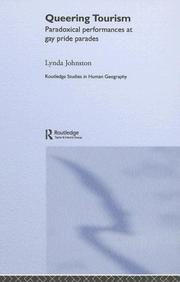| Listing 1 - 3 of 3 |
Sort by
|
Book
ISBN: 9789462982741 9462982740 9048532787 9789048532780 Year: 2018 Volume: 14 Publisher: Amsterdam Amsterdam University Press
Abstract | Keywords | Export | Availability | Bookmark
 Loading...
Loading...Choose an application
- Reference Manager
- EndNote
- RefWorks (Direct export to RefWorks)
Is queer really anti-identitarian? And how is it experienced at the European level? At queer festivals, activists, artists and participants come together to build new forms of sociability and practice their ideals through anti-binary and inclusive idioms of gender and sexuality. These ideals are moreover channeled through a series of organizational and cultural practices that aim at the emergence of queer as a collective identity. Through the study of festivals in Amsterdam, Berlin, Rome, Copenhagen, and Oslo, this book thoughtfully analyzes the role of activist practices in the building of collective identities for social movement studies as well as the role of festivals as significant repertoires of collective action and sites of identitarian explorations in contemporary Europe.
Gay pride parades --- Gay liberation movement --- Sociology of the family. Sociology of sexuality --- Sociology of cultural policy --- Community organization --- Europe --- Gay pride marches --- LGBT pride parades --- Pride parades, Gay --- Gay pride celebrations --- Parades --- Gay and lesbian liberation movement --- Gay and lesbian movement --- Gay and lesbian rights movement --- Gay lib --- Gay movement --- Gay rights movement --- Homophile movement --- Homosexual liberation movement --- Homosexual movement --- Homosexual rights movement --- Lesbian liberation movement --- Lesbian rights movement --- Social movements --- Gay pride parades. --- Gay pride parades - Europe. --- Gay liberation movement - Europe --- The arts: general issues --- Electronic, holographic & video art
Book
ISBN: 1315474034 1315474050 1315474042 1138202398 Year: 2018 Publisher: New York : London : Routledge,
Abstract | Keywords | Export | Availability | Bookmark
 Loading...
Loading...Choose an application
- Reference Manager
- EndNote
- RefWorks (Direct export to RefWorks)
The Open Access version of this book, available at http://www.tandfebooks.com/doi/view/10.4324/9781315474052, has been made available under a Creative Commons Attribution-Non Commercial-No Derivatives 4.0 licensePride Parades and LGBT Movements contributes to a better understanding of LGBT protest dynamics through a comparative study of eleven Pride parades in seven European countries?– Czech Republic, Italy, Netherlands, Poland, Sweden, Switzerland, the UK?– and Mexico. Peterson, Wahlström and Wennerhag uncover the dynamics producing similarities and differences between Pride parades, using unique data from surveys of Pride participants and qualitative interviews with parade organizers and key LGBT activists. In addition to outlining the histories of Pride in the respective countries, the authors explore how the different political and cultural contexts influence: Who participates, in terms of socio-demographic characteristics and political orientations; what Pride parades mean for their participants; how participants were mobilized; how Pride organizers relate to allies and what strategies they employ for their performances of Pride.This book will be of interest to political scientists and sociologists with an interest in LGBT studies, social movements, comparative politics and political behavior and participation.Today, Pride parades are staged in countries and localities across the globe, providing the most visible manifestations of lesbian, gay, bisexual, trans, queer and intersex movements and politics.
Gay pride parades --- Gay liberation movement --- Gays --- History. --- Gay people --- Gay persons --- Homosexuals --- Persons --- Gay pride marches --- LGBT pride parades --- Pride parades, Gay --- Gay pride celebrations --- Parades --- Gay and lesbian liberation movement --- Gay and lesbian movement --- Gay and lesbian rights movement --- Gay lib --- Gay movement --- Gay rights movement --- Homophile movement --- Homosexual liberation movement --- Homosexual movement --- Homosexual rights movement --- Lesbian liberation movement --- Lesbian rights movement --- Social movements --- Social Movements --- LGBT Politics --- Pride Movement --- Pride Parade --- Comparative Politics --- European Politics --- Sexuality Studies --- Social Movement Theory --- Party Politics --- Protest --- Civil Society --- New Social Movements --- Ronald Holzhacker --- Mattias Wahlström --- Magnus Wennerhag

ISBN: 0415298008 9780415298001 0203963806 9780203963807 9786611157883 6611157883 1134429142 1281157880 9781134429097 9781134429134 9780415482103 0415482100 Year: 2005 Publisher: London New York, N.Y. Routledge
Abstract | Keywords | Export | Availability | Bookmark
 Loading...
Loading...Choose an application
- Reference Manager
- EndNote
- RefWorks (Direct export to RefWorks)
Gay Pride parades are annual arenas of queer public culture, where embodied notions of subjectivity are sold, enacted, transgressed and debated.From Sydney to Rome, Queering Tourism analyses the paradoxes of gay pride parades as tourist events, exploring how the public display of queer bodies - the way they look, what they do, who watches them, and under what regulations - is profoundly important in constructing sexualized subjectivities of bodies and cities. Drawing on extensive collections of interviews, visuals and written media accounts, photographs, advertisement
Gay Pride Day. --- Gay pride parades. --- Gays --- Gays. --- Homosexuality. --- Lesbians --- Lesbians. --- Travel. --- Same-sex attraction --- Sexual orientation --- Bisexuality --- Female gays --- Female homosexuals --- Gay females --- Gay women --- Gayelles --- Gays, Female --- Homosexuals, Female --- Lesbian women --- Sapphists --- Women, Gay --- Women homosexuals --- Women --- Gay people --- Gay persons --- Homosexuals --- Persons --- Gay and Lesbian Pride Day --- Gay Freedom Day --- Gay Liberation Day --- GLBT Pride Day --- Lesbian and Gay Pride Day --- LGBT Pride Day --- Pride Day, Gay --- Gay pride celebrations --- Special days --- Gay pride marches --- LGBT pride parades --- Pride parades, Gay --- Parades --- Gay people. --- Gay men. --- Gay men
| Listing 1 - 3 of 3 |
Sort by
|

 Search
Search Feedback
Feedback About UniCat
About UniCat  Help
Help News
News